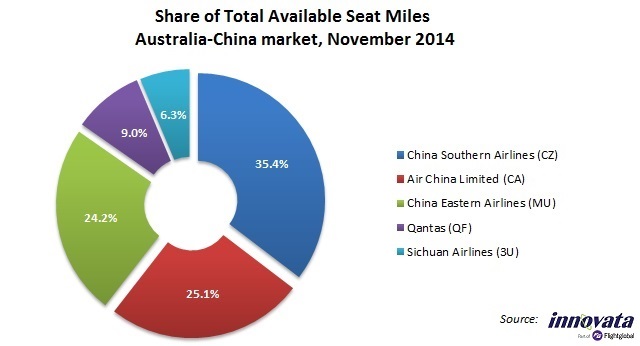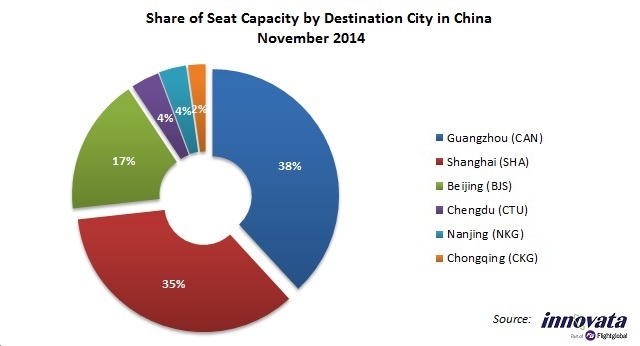“The good fighters of old first put themselves beyond the possibility of defeat, and then waited for an opportunity of defeating the enemy,” said ancient Chinese general Sun Tzu, and the proposed Qantas-China Eastern Airlines joint venture looks to be aimed at doing just that.
The two airlines announced plans to start a joint venture in mid-2015, subject to regulatory approvals, on the same afternoon as their respective countries signed a free trade agreement. The latter is likely to propel already strong trade, underpinned by minerals exports, even further.
Although that trade is slowing as demand for iron ore and other commodities from China comes off the boil, tourism has continued to grow strongly. Data from Tourism Research Australia shows that in the 2013-2014 financial year, tourism expenditure from China grew by 16.3% to A$5.2 billion ($4.53 billion), making it by far the largest overseas tourism market.
In theory, that should mean that Qantas should have a major slice of that market, but Innovata schedule data shows that it remains behind China’s big three carriers.

Historically, China has proven to be a tough market for Qantas. The airline once served both Beijing and Shanghai, but in 2009 it dropped Beijing. It now operates just one daily China flight, on the Sydney-Shanghai route.
While it has kept its own services static, the Australian carrier has steadily grown its codeshare relationship with China Eastern. The two airlines have mutual codeshares on their respective domestic networks, across to New Zealand and also covering connections with Qantas’s services to Hong Kong and Singapore.
Last year it also extended the friendship to China Southern Airlines, with the two carriers entering into a complementary codeshare, extending their reaches in their opposing domestic markets. Qantas also places its code on China Southern’s flights to Sydney, Melbourne, Brisbane and Perth.
It is those services that have made China Southern into the dominant player on Australia-China routes, accounting for just over 35% of capacity. Consequently, Guangzhou is the destination with the most capacity, followed by China Eastern’s Shanghai hub.

A large part of that expansion has been a consequence of China Southern’s desire to turn Guangzhou into a major connecting hub. In Australia, it has heavily marketed the ‘Canton route’ as another option for travellers heading to Europe, which in part explains why it has chosen to diversify its routes away from Sydney and Melbourne.
Clearly, that would limit any further potential relationship that Qantas could develop with China Southern, and widens the appeal of the joint venture with China Eastern.
Consequently, the codeshare between China Southern and Qantas is likely to, at best, stay at arms’ length, or could be dropped if competition authorities push for it as part of the joint venture approval.
That could open up the likelihood of opening up more city pairs from Shanghai, albeit mostly on China Eastern’s metal. Qantas’s fleet constraints will probably prevent it from adding more services, while its partner will have the benefit of relatively lower operating costs.
For Qantas, the joint venture also gives it a better platform to compete with Cathay Pacific and Singapore Airlines, which have been gaining ground in the greater China market. Cathay has the upper hand, thanks to its equity relationship with Air China and the reach of its Dragonair unit, while SIA has the benefit of its alliance with Virgin Australia to counteract the geographic disadvantage of its Singapore hub, relative to Hong Kong.
In another way, the JV also presents something of a backstop solution for the Australian carrier should its other dalliance with China Eastern – as partners in Jetstar Hong Kong – fail to get the go-ahead. As Jetstar Asia does in Singapore, Jetstar Hong Kong could provide Qantas with major feed into greater China and the wider North Asia market. Now, with a direct relationship with China Eastern, the same result could be achieved through Shanghai, and importantly with a lot less risk than the chronically delayed Jetstar Hong Kong venture.
Altogether, it seems that Qantas and China Eastern are putting themselves beyond the defeat of their rivals quite effectively.
Source: Cirium Dashboard



















